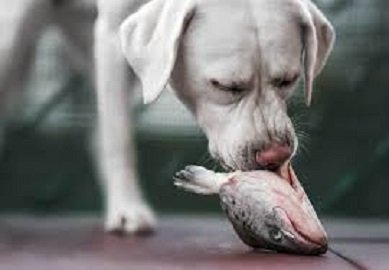As a dog owner, are you constantly worried about providing the right diet for your dog? Yes, fish is great, but can dogs eat fish heads too? Are they safe to consume or not?
The answer is yes, most fish heads are safe to eat, but not every type, and even then certain precautions must be kept in mind while doing so, which we will go over in this article.

How fish heads can be good for your dog
LOW FAT:
Fish heads can be your dog’s new favorite part of their meal. Not only do dogs love juicy and tender fish meat, but since it’s so low in fat, it can also save them from grave diseases such as heart problems, swelling of joints, cancer, etc.
IRON AND ZINC SOURCE:
Iron and Zinc are also a notable composition of fish heads, and they are widely used in the dog’s bodies which adds another benefit to fish heads. These minerals are not reserved within the body of dogs, hence they require a constant intake, for which fish heads are perfect.
HEALTHY OILS:
Salmon heads are rich in Omega-3 fatty acids, and also contain good amounts of vitamins A, and calcium which help keep your canine’s bones and immune system strong, along with providing healthy nourishing skin. Besides, it also eliminates the need of giving them fish oil separately as fish heads in their raw form contain everything their body needs. Collagen is another important mineral and is vital for dogs’ growth.
How nutrients in Fish can help your dog
Studies show that these minerals are assimilated way more efficiently in animals’ bodies, and helps in the development of skin, reducing dryness and flakiness, leaving them feeling well-nourished.
Just make sure not to overdo it, a 1/10th portion of fish in their meal is enough to provide the right amount of nutrients for your pooch to live a robust life.
Make them bite-sized
It is recommended to break the fish heads down into smaller pieces while feeding your dog, especially in the beginning to avoid any chances of your dog choking because of the bones, and also to get them used to this new change in their diet.
Precautions to take while feeding fish heads
Dog Allergies
Before feeding your dog fish heads, it is important to make sure they don’t have any allergies that can harm their health. Even though dogs do not usually have fish allergies, if an allergy does occur then you will most likely observe visible signs of it, like dry coat and skin, infections, or even wheezing at times. Try not to use garlic or season the fish while cooking, as this can cause allergic reactions in your dog.
Make sure to test out your dogs’ reaction to fish heads by giving them a small portion first, and then slowly increasing it to the optimal level required in their diet. If any allergies occur, seek professional help immediately and discontinue fish heads from their diet, or as advised by the vet.
The ideal amount of fish heads your dog can eat
This factor will vary for each dog, depending on the current nutritional servings, health, and the vet’s recommendation.
As with anything in the world, even the best things taken in surplus can result in adversity, so it’s highly suggested to keep a balance of the diet. Too many fish heads can harm your pooch and increase their weight profusely.
WHAT VETS SAY:
Generally, vets suggest that dogs can eat fish heads around 2 to 5 times a week, in properly balanced portions to maintain their health at an optimal level.
For a smaller-sized dog, your vet might recommend different portions, so make sure to consult them before feeding your dog.
Cooked or raw fish heads: which is better?
There is a lot of confusion on the internet regarding whether dogs should be fed raw fish heads or should they be cooked before serving.
But based on research, the latter is better, let us explain why.
Why avoid raw fish heads:
Raw fish heads are prone to different types of infections and bacteria like salmonella, which, if ingested, can make your dog fall victim to diarrhea, vomiting, fever, and in the worst-case scenario, even take its life. Infected salmon can also cause salmon poisoning to your dog, but this can be avoided if the fish is cooked thoroughly before intake.
Cooked fish heads are the way to go:
Boiled, steamed, or even baked fish works, and some even say that freezing your fresh raw fish for around 4 weeks so that the organism becomes inactive, before serving it normally. Fish heads can be fried too, but care should be taken with the amount of oil used as it can increase cholesterol in your dog resulting in heart problems.
Undoubtedly, your vet has the best knowledge about what will suit your dog and can advise you in the best manner.
Fish heads to avoid
Some fishes have high levels of mercury, because of the seawater, and they may prey on fishes that contain higher levels of mercury as well. These fishes are:
- Bigeye tuna
- Sharks
- Mackerel
- Swordfish,
If ingested, these can cause problems in the internal functions of dogs. Excess of mercury in their furry body is harmful and can affect the functionality of their organs, in turn affecting their quality of life.
Fish heads best suited for your dog
As mentioned above, there might be only certain types of fish heads your dog might prefer to eat, but the most common types of fish heads that are widely available in most stores are:
- Salmon
- Herring
- Arctic charr
- Sardines
- Flounder
These are proven to have lower levels of mercury and a reduced risk of being infected by parasites, which is why they are the go-to fishes for most dog owners. Most of these also come from a family of shorter bodies, so they have tender bones that are easier for dogs to eat and digest.
More importantly, even though they are safe to consume, you must still consult a vet before allowing the dog eat fish heads, as they will help you identify the right fish choice for your doggy.
AVOID BIG HEAD FISH:
Besides, the larger the fish, the bigger its bones are going to be, which can be hazardous if your dog accidentally chokes on them. Sometimes the bones from the fish head also cause internal obstruction in their little bodies, in which case it is important to seek medical health before further damage.
It is recommended to get the best quality of fish for your dog, preferably from freshwaters instead of fish farms, as fish from farms could be treated with medicines and harmful toxic materials, which may not be good for your dog.
Conclusion
So if you’ve been stuck in a rut about whether feeding your dog fish heads is the right thing to do, hopefully, this article cleared your query!
To summarize, the right amount of fish heads per serving can help dogs gain the vitamins, calcium, and omega-3 fatty acids they need to spend their life comfortably. They also help them stay active and keep their immune system strong.
Finally, the fish head of the right fish must be chosen for your dog based on the guide above to avoid unforeseen illnesses. Your vet and his/her advice are your best friend when it comes to your dog’s health and diet. Take note of the precautions and help your dog live a happy and healthy life.
After all, a healthy dog is a happy dog!

